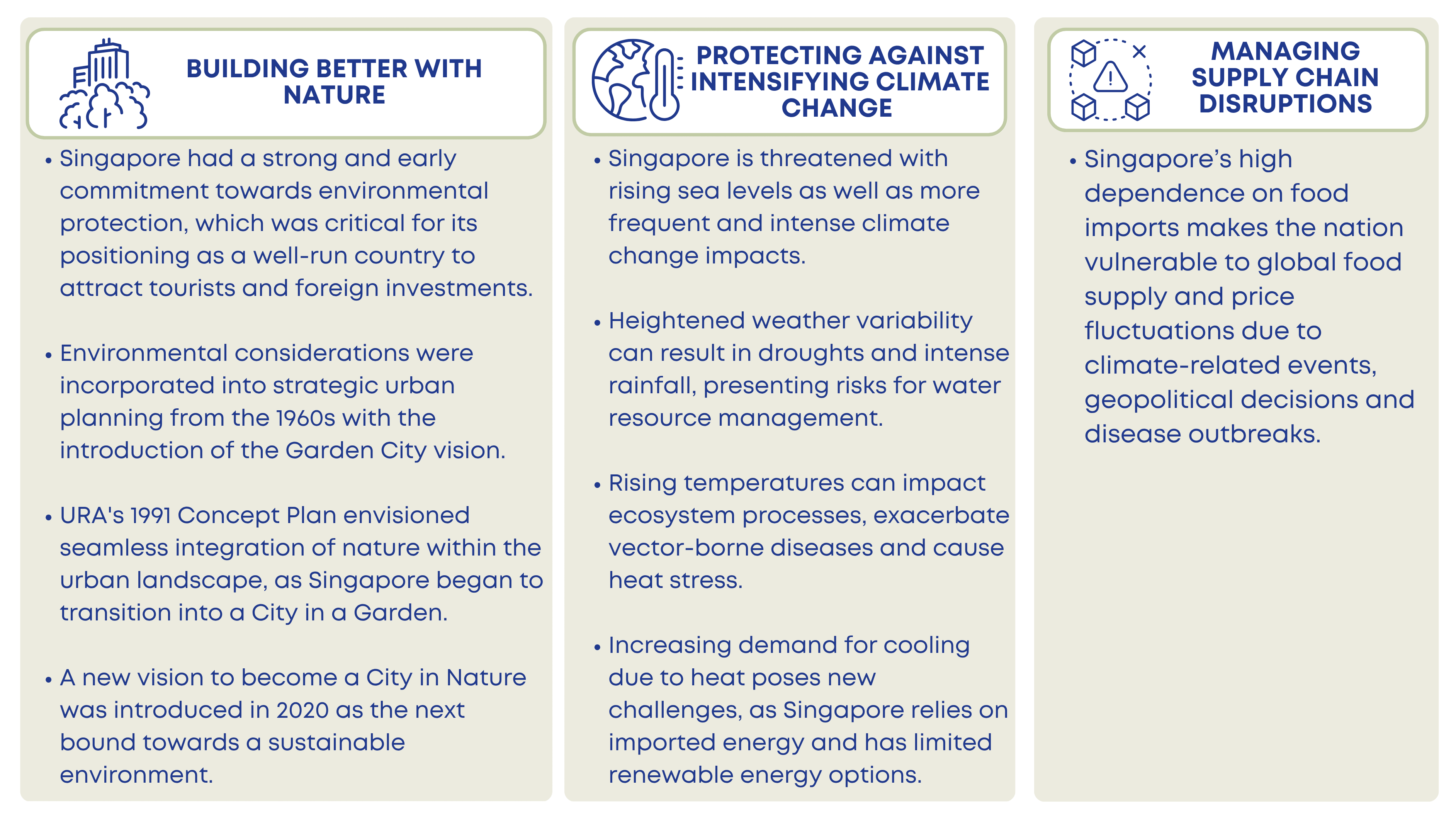Sustainable Environment
Discover how Singapore creates a thriving city that coexists harmoniously with nature.
On this page

Bishan-Ang Mo Kio Park provides residents with access to green and blue spaces amid urban living (AtelierDreiseitl (CC BY-SA 3.0) / Wikimedia Commons)
A sustainable environment is a fundamental goal that Singapore has consistently pursued. To achieve a sustainable environment means grappling with a new reality characterised by heightened climate change impacts, including rising sea levels and temperatures leading to flooding and heat stress.
Addressing these risks demands a whole-of- society approach, integrating physical and social infrastructures to enhance resilience and resource sustainability through nature-based solutions. It also involves actively enhancing and re-imagining what Singapore can do with its natural resources given its land constraints.
Contextual Considerations

Environmental Protection

Featuring native plants, the Bedok Nature Way along Bedok South Ave 1 creates a connection between the green spaces at Bedok Reservoir Park and East Coast Park (National Parks Board)
A sustainable environment encompasses environmental protection and emphasises responsible use of resources. In Singapore, it involves actively conserving its natural ecosystems, protecting its biodiversity and promoting the long-term health of the environment.
Through the City in Nature vision, Singapore aims to further integrate nature into the urban landscape in order to promote biodiversity and enhance the overall well-being of Singapore’s communities. In addition to plans to naturalise gardens and parks through biophilic and nature-based design, and intensifying planting efforts to incorporate greenery into residents’ daily lives, Singapore is focusing on conserving and connecting its natural habitats.
Conserving and Connecting Natural Habitats
Nature parks: An additional 200 hectares of new nature parks will be established by 2030. Nature parks are green spaces on the edges of Singapore’s nature reserves which act as buffers from development, offer complementary habitats for biodiversity and provide alternative green spaces for public enjoyment.
Nature ways: By 2030, Singapore aims to have a total of 300 km of nature ways. These ecological corridors facilitate the movement of birds and butterflies by linking nature reserves and other green spaces across the island.
Resource Security

The Sembcorp Tengeh Floating Solar Farm is one of the world’s largest inland floating solar farms (Sembcorp)
Achieving a sustainable environment also involves maintaining resource security. This includes ensuring access to water, food and energy for residents. As a resource-scarce city, Singapore has strengthened its resilience through innovation and strategic planning — from diversifying water sources through the Four National Taps strategy, to enhancing local food production and balancing energy needs with environmental goals. These approaches help secure key resources despite global and local constraints.
Water Security
Four National Taps: To diversify its water sources, Singapore has developed the Four National Taps — local catchment, imported water, NEWater (recycled water) and desalinated water. Leveraging innovative methods for harnessing and reusing water, and through public and private partnerships, Singapore has successfully grown a robust and diversified water sector.
Food Security
Local food production: To help local farms become more productive and resilient, Singapore is availing land and infrastructure for farming, facilitating regulatory clearances for farm construction, improving energy efficiency and productivity, and encouraging demand offtake.
Energy Security
Renewable energy sources: To achieve national climate targets to reach net-zero emissions by 2050, Singapore is advancing solar energy adoption while optimising its limited land and ensuring energy security. Key initiatives include the SolarNova initiative, which drives solar photovoltaic (PV) implementation across the island, and innovative solutions like the 60 megawatt-peak floating solar PV system on Tengeh Reservoir, which taps on available reservoir space to harness solar power in land-scarce Singapore.
Tuas Nexus: To promote resource efficiency, circularity is used to close the loop through reuse, recycling and repurposing, ultimately reducing environmental impact and fostering a more sustainable and resilient economy. The Tuas Nexus exemplifies this approach by integrating the PUB's Tuas Water Reclamation Plant and National Environment Agency's Integrated Waste Management Facility to co-locate water reclamation, solid waste treatment and energy recovery processes.
Urban Resilience

Promoting active mobility contributes to Singapore’s sustainability goals (Unsplash)
Singapore is strengthening its resilience across three interconnected fronts—resource, climate and social. Singapore's experience with COVID-19 highlighted how supply chain disruptions can impact resource security and liveability. Singapore must strengthen resilience across all levels—from securing vital resources like water, energy and food, to building climate resilience against environmental challenges.
Building social resilience is crucial for Singapore's sustainability journey, requiring both community mobilisation and policy measures to drive sustainable behaviours and lifestyle changes. From climate adaptation measures, environmental education and incentives for sustainable lifestyles, these efforts ensure that individuals, communities, and city systems can better withstand and emerge stronger from shocks over the long-term.
Climate Resilience
Flood mitigation infrastructure and strategies: Include the PUB’s long-term planning for coastal protection measures against sea level rise, as well as its continuous upgrading of drainage infrastructure to better mitigate inland flooding. For instance, the PUB has been promoting the adoption of flood mitigation infrastructure and strategies, including flood-proof buildings, elevated structures, flood gates and water-sensitive urban design.
Social Resilience
Eco Stewardship Programme: Enhances sustainability education within the curriculum and through school initiatives. Launched as part of the Singapore Green Plan 2030, this programme involves all schools from primary to pre-university.
Greening Schools for Biodiversity Programme: Enables schools to cultivate indigenous flora and establish habitats for diverse wildlife. This brings students closer to nature and fosters their stewardship of Singapore’s natural habitats and biodiversity.
Incentives to support sustainable behaviours: Include policies such as mandatory charges for disposable carrier bags, and Climate Vouchers available under the enhanced Climate Friendly Households Programme which encourage households to switch to more energy- and water-efficient household products.
Opinion: Energy, Secured – Why Grid Resilience is Key to Singapore’s Clean Energy Transition
By S. Harsha, Managing Director, Sustainable Energy Solutions (Singapore), SP Group
